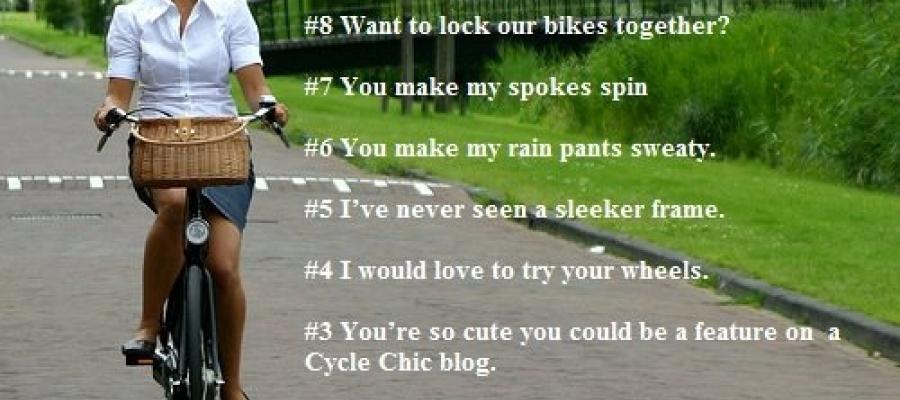Yesterday, I indulged in a bit of "What If?"cycling history. If Greg LeMond hadn't won the 1986 Tour, would Americans be aware of bike racing at all? If he hadn't finished--and won--the 1989 Tour in such dramatic fashion, would many Americans care? And, if Lance hadn't raced from 1999 to 2005, would any cyclist have become a celebrity in the US?
Now, I'm going to engage in a bit of "What If?" about the bicycle itself.
What if the "safety" bicycle--one with two wheels of equal (or nearly equal) size, i.e., what most of us ride today--hadn't been invented? What if we were still riding "penny farthings": bikes with on which the pedals and cranks are affixed to the axle of the front wheel, which is usually much bigger than the rear?
Well, for one thing, to obtain a gear anything like what I ride normally, I would need a front wheel that's as tall--or even a bit taller--than I am! So would most cyclists, I believe. Since I have never ridden a "penny farthing", I can only imagine how it feels. My guess is that it's something like riding a fixed-gear bike that's a few sizes too large. Riding a fixie on a frame that's a couple of centimeters too high is difficult enough; I don't want to think about what it would be like on a bike that's about twice as high as what I ride!
I won't even try to conceive of what it would be like to ride such a bike with a motor.
Apparently, though, someone has thought about it.
The designers of Ding3000, a German design studio, worked with BASF to come up with what riders in the Tour, Giro and Vuelta might be riding if someone hadn't realized that a bike with two wheels the same size and a gear-and-chain drive is safer and more efficient than a bike with a very tall front wheel.
You see, this bike not only has a motor in it (which makes the latest form of "doping" possible), it is made of "thermoplastic polyurethane". Now, we all know that the carbon fiber tubes used in bike frames are woven strands bound together with a resin (plastic). So, in terms of technology, the modern penny-farthing would seem to be a cousin-in-an-alternative universe to the bikes ridden in today's races.
But you could take this modern relic on your daily commute: It is equipped with puncture-proof tires and integrated LED lighting. And, I guess that sitting up so high on the wheel would make you visible to drivers!
What would it be like to see throngs of cyclists pedaling penny-farthings to work every day, or taking trips to parks and beaches?
Or--what if all of those guys (nearly all are male) who deliver pizzas and Chinese food were to trade their e-bikes or motorized bikes for the Ding3000-BASF concoction?
Now, I'm going to engage in a bit of "What If?" about the bicycle itself.
What if the "safety" bicycle--one with two wheels of equal (or nearly equal) size, i.e., what most of us ride today--hadn't been invented? What if we were still riding "penny farthings": bikes with on which the pedals and cranks are affixed to the axle of the front wheel, which is usually much bigger than the rear?
Well, for one thing, to obtain a gear anything like what I ride normally, I would need a front wheel that's as tall--or even a bit taller--than I am! So would most cyclists, I believe. Since I have never ridden a "penny farthing", I can only imagine how it feels. My guess is that it's something like riding a fixed-gear bike that's a few sizes too large. Riding a fixie on a frame that's a couple of centimeters too high is difficult enough; I don't want to think about what it would be like on a bike that's about twice as high as what I ride!
I won't even try to conceive of what it would be like to ride such a bike with a motor.
Apparently, though, someone has thought about it.
The designers of Ding3000, a German design studio, worked with BASF to come up with what riders in the Tour, Giro and Vuelta might be riding if someone hadn't realized that a bike with two wheels the same size and a gear-and-chain drive is safer and more efficient than a bike with a very tall front wheel.
You see, this bike not only has a motor in it (which makes the latest form of "doping" possible), it is made of "thermoplastic polyurethane". Now, we all know that the carbon fiber tubes used in bike frames are woven strands bound together with a resin (plastic). So, in terms of technology, the modern penny-farthing would seem to be a cousin-in-an-alternative universe to the bikes ridden in today's races.
But you could take this modern relic on your daily commute: It is equipped with puncture-proof tires and integrated LED lighting. And, I guess that sitting up so high on the wheel would make you visible to drivers!
What would it be like to see throngs of cyclists pedaling penny-farthings to work every day, or taking trips to parks and beaches?
Or--what if all of those guys (nearly all are male) who deliver pizzas and Chinese food were to trade their e-bikes or motorized bikes for the Ding3000-BASF concoction?

